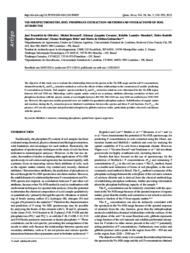Vis-NIR spectrometry, soil phosphate extraction methods and interactions of soil attributes.
Vis-NIR spectrometry, soil phosphate extraction methods and interactions of soil attributes.
Author(s): OLIVEIRA, J. F. de; BROSSARD, M.; CORAZZA, E. J.; MARCHAO, R. L.; VENDRAME, P. R. S.; BRITO, O. R.; GUIMARAES, M. de F.
Summary: Abstract: The objective of this study was to evaluate the relationships between the spectra in the Vis-NIR range and the soil P concentrations obtained from the P-M and P-rem extraction methods as well as the effects of these relationships on the construction of models predicting P concentration in Oxisols. Soil samples' spectra and their P-M and P-rem extraction solutions were determined for the Vis-NIR region between 400 and 2500 nm. Mineralogy and/ or organic matter content act as primary attributes allowing correlation of these soil phosphorus fractions with the spectra, mainly at wavelengths between 450-550, 900-1100 nm, near 1400 nm and between 2200-2300 nm. However, the regression models generated were not suitable for quantitative phosphate analysis. Solubilization of organic matter and reactions during the P-M extraction process hindered correlations between the spectra and these P soil fractions. For P-rem,, the presence of Ca in the extractant and preferential adsorption by gibbsite and iron oxides, particularly goethite, obscured correlations with the spectra.
Publication year: 2015
Types of publication: Journal article
Unit: Embrapa Cerrados
Observation
Some of Embrapa's publications are published as ePub files. To read them, use or download one of the following free software options to your computer or mobile device. Android: Google Play Books; IOS: iBooks; Windows and Linux: Calibre.
Access other publications
Access the Agricultural Research Database (BDPA) to consult Embrapa's full library collection and records.
Visit Embrapa Bookstore to purchase books and other publications sold by Embrapa.

